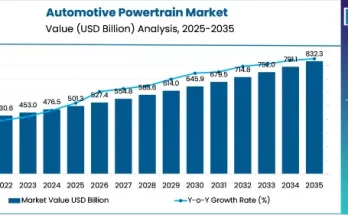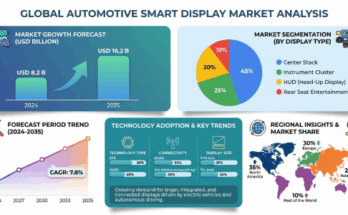The global automotive filter market is projected to expand from USD 20.0 billion in 2025 to USD 32.0 billion by 2035, registering a CAGR of 4.8%, according to Fact.MR, a leading market research and competitive intelligence provider. The market is witnessing strong growth fueled by rising consumer awareness, stringent environmental regulations, and the rapid adoption of electric and hybrid vehicles. Over the forecast period, the market is expected to generate an absolute $ opportunity of approximately USD 12 billion.
Market Overview
-
Market Value (2024A): USD 19.2 billion
-
Estimated Value (2025E): USD 20.0 billion
-
Forecast Value (2035F): USD 32.0 billion
-
Forecast CAGR (2025–2035): 4.8%
-
East Asia Market Share (2025): 21.4%
-
China Market Growth Rate (2025–2035): 6.3% CAGR
Automotive filters—including fuel, oil, air, and cabin air filters—play a critical role in protecting engine components, enhancing vehicle performance, and ensuring air quality inside vehicles. Advanced filtration materials are increasingly being used to capture impurities efficiently, supporting engine longevity and passenger health.
Market Drivers
-
Government Regulations and Incentives: Policies aimed at reducing vehicle emissions, enhancing environmental sustainability, and promoting deep localization are driving market growth. For example, India’s PLI-Auto Scheme with a USD 3.1 billion budget supports the production of advanced automotive technology (AAT), boosting local manufacturing and market expansion.
-
EV and Hybrid Vehicle Adoption: The rise of electric and hybrid vehicles requires new filtration technologies to meet unique thermal, cabin, and engine demands.
-
Consumer Awareness: Growing emphasis on vehicle maintenance and health-conscious choices is driving demand for premium filters, particularly cabin air filters.
-
Technological Innovation: Companies are investing heavily in R&D to create high-efficiency filters using materials like nanofibers and multi-stage HEPA systems.
Market Segmentation
By Product Type:
-
Cabin Air Filters: Fastest-growing segment, CAGR 4.9% (2025–2035). Rising urban pollution and health-conscious consumers drive adoption.
-
Fuel Filters, Oil Filters, Intake Air Filters: Steady demand for engine performance and longevity.
By Vehicle Type:
-
Passenger Cars (PC): Largest share.
-
Light Commercial Vehicles (LCV) & Heavy Commercial Vehicles (HCV): Growth fueled by logistics and industrialization.
-
Off-Road Vehicles & Lawn Mowers: Niche segments with specialized filtration needs.
By Filter Media:
-
Synthetic: High-performance applications; EV and premium vehicle adoption.
-
Cellulose: Cost-effective, widely used in conventional vehicles.
By Sales Channel:
-
OEM (Original Equipment Manufacturer): Dominates revenue; primary integration in new vehicles.
-
OES (Original Equipment Supplier): Supplies to OEMs; supports aftermarket and replacement cycles.
-
IAM (Independent Aftermarket): Fastest-growing channel; replacement demand, especially in aging vehicles.
Regional Insights
-
United States: Market size USD 5.2 billion in 2025; CAGR 4.4% through 2035. Growth driven by fuel efficiency initiatives, lightweight filters, and expansion into Canada and Mexico.
-
China: Estimated market USD 4.1 billion by 2035; CAGR 6.3%. Growth supported by production migration, cost advantages, and government infrastructure investment. China will hold 52% of East Asia’s automotive filter market by 2025.
-
Europe: Growth driven by stringent emissions and clean air regulations, especially in Germany, France, and the Netherlands.
-
Asia-Pacific (Other than China): Rapid vehicle production and rising EV adoption spur demand.
-
LAMEA (Latin America, Middle East & Africa): Emerging markets; growth supported by industrialization and regulatory compliance.
Historical Market Performance (2020–2024)
-
Market Size (2020A): USD 16.3 billion
-
Market Size (2024A): USD 19.2 billion
-
Historical CAGR (2020–2024): 4.0%
Forecast Period Analysis (2025–2035)
-
Short Term (2025–2028): Growth driven by emissions regulations, EV adoption, fuel efficiency, and consumer environmental awareness.
-
Medium Term (2028–2032): Expansion supported by stricter environmental laws, advanced filtration technologies, and premium cabin air filter adoption.
-
Long Term (2030–2035): Rising demand for specialized EV filters, nanofiber technologies, and sustainable filtration solutions to enhance engine performance and reduce environmental impact.
Competitive Landscape
Key players include:
-
Mann+Hummel GmbH
-
Cummins Inc
-
Parker Hannifin Corporation
-
K&N Engineering Inc
-
Toyota Boshoku Corporation
-
Donaldson Company Inc
-
Hollingsworth & Vose Company
-
ALCO Filters Ltd
-
MAHLE GmbH
-
Denso Corporation
-
Roki Co. Ltd
Recent Developments:
-
Jan 2025: MANN+HUMMEL launched MANN-FILTER PU 10 023/1 z KIT for pickups. Achieves 96% particle separation and removes 95% of water from diesel fuel.
-
Apr 2023: FRAM launched Synthetic Endurance™ oil filter at Walmart, offering 99% filtration efficiency and up to 25,000 miles protection.
Market Challenges
-
High Cost of Filter Media: Advanced materials increase production costs and retail prices.
-
Complex Manufacturing: Smaller companies struggle to compete with established players.
-
Price Sensitivity: High-end filters may limit adoption in cost-sensitive markets.
Browse Full report : https://www.factmr.com/report/33/automotive-filter-market
Outlook
The automotive filter market will continue its steady expansion, driven by cabin air filters, EV-specific filtration, and innovative materials. Government regulations, technological advancements, and growing environmental awareness will shape the competitive landscape. Companies investing in R&D and sustainable filtration solutions are expected to lead market growth through 2035.



